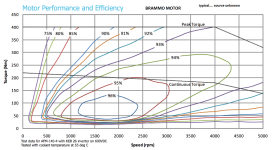hello guys
sorry if my questions are stupid .
i wonder if today there are m-controllers available that can change the motor configuration from delta to wye and vice versa on the go , in order to get max efficiency for torque and rpm .
what i mean is the motor has 6 wires , and controller can reconfigure the winding on the go for wye or delta .
is such a thing available ?
do you also think this can improve efficiency ?
thanks
sorry if my questions are stupid .
i wonder if today there are m-controllers available that can change the motor configuration from delta to wye and vice versa on the go , in order to get max efficiency for torque and rpm .
what i mean is the motor has 6 wires , and controller can reconfigure the winding on the go for wye or delta .
is such a thing available ?
do you also think this can improve efficiency ?
thanks



